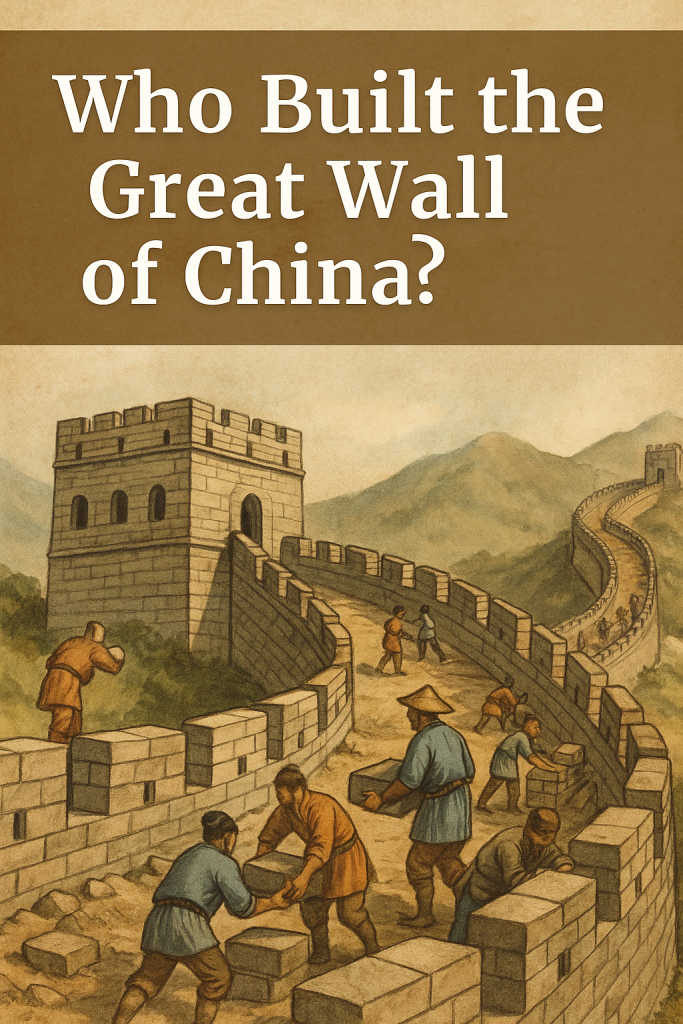The Great Wall of China is one of the most remarkable architectural achievements in human history. Its construction was not the work of a single emperor or dynasty, but rather a long-term effort that spanned more than 2,000 years, involving multiple states, dynasties, and millions of workers.

Origins in the Spring and Autumn Period (7th Century BC)
The earliest origins of the Great Wall can be traced back to the Spring and Autumn Period (770–476 BC), when regional states began to build walls and trenches around their territories to defend themselves. Archaeological discoveries have confirmed that these early fortifications marked the beginning of the Great Wall’s history.
During this time, city-states and clans relied on earth walls and moats to protect against invasions from neighboring states and nomadic tribes. These rudimentary defenses laid the foundation for what would later become the Great Wall of China.
The Warring States Period (475–221 BC)
The Warring States Period saw large-scale construction of defensive walls as rival states, including Yan, Zhao, and Qin, strengthened their borders. These walls were designed to resist attacks from nomadic tribes of the north and from hostile states within China.
Each state built its own independent walls, which were later connected after the unification of China.
Qin Dynasty (221–206 BC)
In 221 BC, after Emperor Qin Shi Huang unified China, he ordered the connection of the existing walls built by the states of Qin, Zhao, and Yan.
This project created a continuous northern defensive line, stretching thousands of miles from modern-day Gansu in the west to Liaodong in the east.
Construction during the Qin Dynasty was extremely harsh. Historical records suggest that hundreds of thousands of soldiers, peasants, and prisoners were conscripted to build the wall. Many perished during the process, giving rise to legends that the Wall became a “long graveyard.”
Han Dynasty (206 BC – 220 AD)
The Han Dynasty expanded the Wall even further, pushing its defense lines westward to protect trade routes along the emerging Silk Road.
These extensions secured China’s northern frontier and safeguarded cultural and economic exchanges with Central Asia.
Ming Dynasty (1368–1644 AD)
The Ming Dynasty (1368–1644) was the era when the Great Wall took on the form most recognizable today. Unlike the earlier earthen walls, the Ming emperors rebuilt and reinforced the Wall using bricks, stone, and stronger materials, creating a more sophisticated defensive system.
Key features included:
- Watchtowers for surveillance and communication.
- Fortresses and passes (e.g., Juyongguan, Jiayuguan, Shanhaiguan) to control movement.
- Beacon towers to send smoke or fire signals during invasions.
The Ming Wall stretched over 8,800 kilometers (5,500 miles), making it the most complete and enduring version of the Great Wall.
Who Built the Great Wall?
The Great Wall was built by millions of workers across different dynasties, including:
- Soldiers conscripted for military duty.
- Farmers and peasants recruited or forced into labor.
- Prisoners and convicts, who were often punished with wall construction.
- Ethnic minorities, who also contributed labor and materials.
It is estimated that over 20 dynasties built or repaired sections of the Great Wall throughout history, leaving behind many remains that can still be seen today.
Conclusion
The Great Wall of China was not the achievement of a single ruler or era, but a collective effort spanning centuries. From its beginnings in the Spring and Autumn and Warring States periods, through the grand unification under Qin Shi Huang, the expansion under the Han Dynasty, and the monumental rebuilding during the Ming Dynasty, the Wall became both a symbol of defense and a cultural icon of Chinese civilization.
Today, the Great Wall stands not only as a military relic but also as a UNESCO World Heritage Site and one of the New Seven Wonders of the World, attracting millions of visitors from around the globe.